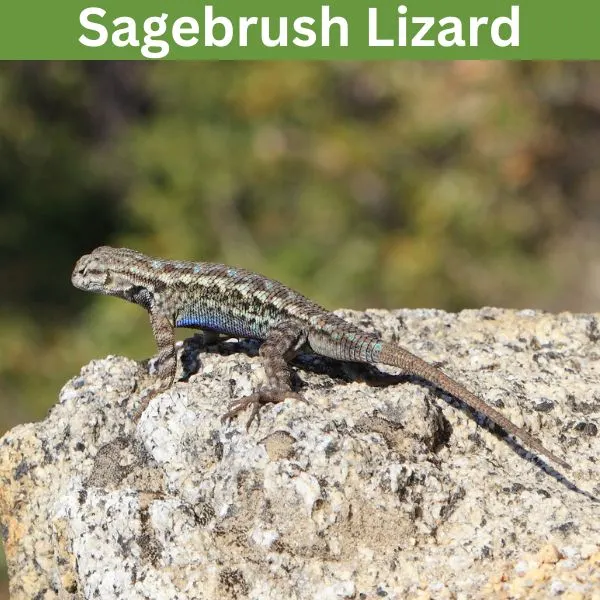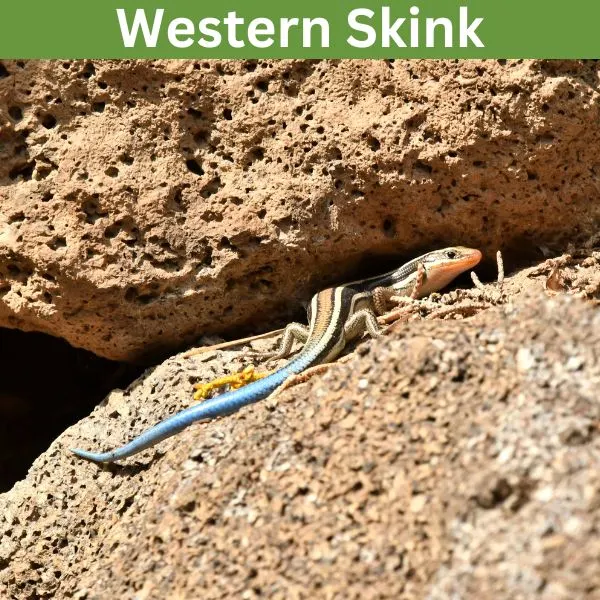There are 7 species of lizards in Washington state. Washington has a diversified ecosystem of prairies, grasslands, wetlands, urban areas, woodlands, and even rainforests. At-least 28 reptiles including lizards, turtles, and snake species live in Washington.
Nature lies on a delicate balance, with animals like lizards being small, but an important part of their environment. You can find lizards in places deep in the wilderness, or some near your home.
This article will go over the 7 lizard species in Washington, and useful facts like their appearance, location, and range in the state. The secretive nature, and camouflage of lizards make them very difficult to spot in the wild, but the more you know the easier it becomes.
Table of Contents
Lizards in Washington State
Anguidae
1. Northern Alligator Lizard

- Experience Level: Intermediate
- Family: Anguidae
- Scientific Name: Elgaria coerulea
- Other Names: n/a
- Adult Size: 10.8 in. (27.5 cm.)
- Lifespan: 7 years
- Average Price Range: $50
Northern alligator lizards are found in the majority of western Washington, but have a scattered population across the state. Grassy, open, and rocky habitats are where this lizard lives. Woodlands, and vegetated areas near water are where you may spot this species.
Alligator lizards are the only lizards that live in Washington that have square scales. Northern alligator lizards have a robust body, with a tan, olive, or gray coloring. Dark markings like stripes, and blotches appear on them. The tails of these lizards are long, but are shorter than the southern species.
Crickets, slugs, spiders, moths, and other invertebrates are what this lizard eats. Their range mainly covers the upper western United States. Their populations are stable, and the day is when these lizards are out, and active.
2. Southern Alligator Lizard

- Experience Level: Intermediate
- Family: Anguidae
- Scientific Name: Elgaria multicarinata
- Other Names: n/a
- Adult Size: 3 to 7 in. (8 to 18 cm)
- Lifespan: 7 years
- Average Price Range: $350
Southern alligator lizards are native to eastern Washington. These lizards are found in the western United States, and are very similar to the northern alligator lizard. Their range, and small differences in appearance is how these lizards can be told apart.
Southern alligator lizards have flat, and plump bodies. Their scales are square, with a tan, olive, or gray color. The flat body of these lizards allow them to squeeze into small crevices within rocks, or even under houses.
Invertebrates on the ground like slugs, insects, and even small mammals are what this lizard eats. They are active most in the spring, mating during this season. These lizards lay around 5 to 20 eggs, which hatch shortly later in summer.
Phrynosomatidae
3. Sagebrush Lizard

- Experience Level: Intermediate
- Family: Phrynosomatidae
- Scientific Name: Sceloporus graciosus
- Other Names: Sagebrush swift
- Adult Size: 2 to 5.9 in. (5 to 14.98 cm.)
- Lifespan: 5 years
- Average Price Range: n/a
The sagebrush lizard is a species found in Washington, and is native to the western United States. Found in shrublands, woodlands, and rocky habitats, this lizard is terrestrial, but uses climbing to escape predators. Sagebrush lizards are active in the day, and their populations are considered stable.
Sagebrush lizards are a small species with tan to gray coloring. They have very keeled scales. The pattern on this lizard is dark and wavy. Sagebrush lizards have a white belly, with males having blue coloring on their bellies.
Being very small this lizard is frightened easily. They will flee, hding in trees, burrows, or other thick vegetation if threatened. Sagebrush lizards are one of the most common lizards in Washington, and spend their day hunting insects like ants, flies, and beetles.
4. Pygmy Short-horned Lizard

- Experience Level: Intermediate
- Family: Phrynosomatidae
- Scientific Name: Phrynosoma douglasii
- Other Names: n/a
- Adult Size: 1 to 3 in. (2.5 to 6.5 cm.)
- Lifespan: 10 years
- Average Price Range: n/a
In the rocky, and semi-arid habitats in the northwestern United States, the pygmy short-horned lizard is possibly one of the spikest lizards you may come across. These lizards are the only horned lizard that lives in Washington. You may not see them since their spikes and coloring match their sandy environment.
Tan, gray, yellow, or reddish are the common colors of this lizard. Spikes cover their body, and they have a flat appearance. These lizards can have dark spots that appear on them. If attacked they will puff out their bodies to make themselves harder to eat.
Harvester ants are the main food this lizard eats. Predators of this lizard include birds, snakes, rats, and red ants. Pygmy short-horned lizards are very similar to the greater short-horned lizard, but that species is not found in Washington. The pygmy short-horned lizard is common mainly in the eastern part of the state.
5. Side-blotched Lizard

- Experience Level: Beginner
- Family: Phrynosomatidae
- Scientific Name: Uta stansburiana
- Other Names: n/a
- Adult Size: 2.5 to 5 inches (6.35 to 12.7 cm.)
- Lifespan: 1 year
- Average Price Range: $12
Common side-blotched lizards are native to the western United States. Dry, and open habitats is where this lizard lives. They are active in the day, and use their coloring, and pattern to camouflage. This lizard has a stable population in its range.
Common side-blotched lizards are small, with females being slightly smaller. They have a tan, or gray coloring. A dark blotch appears on their side, and they have a striped, and blotchy appearance. The color of a male’s throat will determine how they breed, with some using the sneaking, aggressive, or less aggressive method.
This lizard has a large population, and a stable number. They can be very aggressive during the spring breeding seasons, and males will often fight each other. Insects, and arthropods make up the majority of their diet.
6. Western Fence Lizards

- Experience Level: Intermediate
- Family: Phrynosomatidae
- Scientific Name: Sceloporus occidentalis
- Other Names: Blue-belly lizard
- Adult Size: 4 to 7.5 in. (10 to 19 cm.)
- Lifespan: 5 to 7 years
- Average Price Range: $20
Western fence lizards have a scattered population across Washington, and they are native to the eastern United States. These lizards live in grasslands, woodlands, sagebrush, and urban habitats, but they are absent from harsh desert regions. These lizards are active in the day, and are common near homes, and other urban areas.
The scales of these lizards are roughly keeled. They have a coloring that typically ranges from tan, gray, or black. Males have blue coloring that appears on their underside, but some males may be covered in blue.
On fences, and other sunny locations is where this lizard lives. They spend their time feeding on insects, and other small prey. In the mating season this lizard becomes very territorial. They are active for most of the year, with peaks in spring and summer. Winter is when they enter brumation.
Scincidae
7. Western Skink

- Experience Level: Beginner
- Family: Scincidae
- Scientific Name: Plestiodon skiltonianus
- Other Names: n/a
- Adult Size: 4 to 8.25 in. (10.16 to 20.95 cm.)
- Lifespan: 10 years
- Average Price Range: n/a
Western skinks are native to the western United States, and can be found in Washington. They are typically spotted in the eastern half of the state. Woodlands, and hillside habitats are where this species lives. They prefer moist environments, but are occasionally found in dry areas.
This skink has very small, smooth scales. They are tan, olive, gray, or black, with white and dark stripes running down their body. In the breeding season males of this species may have red coloring around their mouth.
Western skinks are diurnal, and spend their day feeding on insects. They are very skittish lizards, and hide, and flee if spotted. Spring is when this species breeds, and they are active until fall. When born these lizards have blue tails, but their colors fade with age.
Where do lizards live in Washington?
Lizards are found all across Washington, but each species has its own preference for where it wants to live. The spring to fall is when lizards are out, and active. Some can be found in the wilderness, while others are more common in urban areas.
In Washington what is the most common lizard?
Lizards from the Phrynosomatidae family are the most commonly found species that live in the state. There are around 4 species of these lizards that live in the state. Skinks are another common lizard that lives in Washington, but there is only one species in the state.
Wrapping up
If you go out on a stroll in the Washington wilderness you will see much more life out than just lizards. While a very small animal, lizards abundance, and ferocious hunger make them important animals in maintaining balance in their ecosystems.
Protecting the habitats that lizards live in will keep the populations of lizard species healthy, but also maintain the overall ecosystem in Washington.
Many of the lizards in the state can make a good pet, but you should never take a lizard from the wild since it may have parasites, or diseases. Be sure to comment down below about your experiences with the lizards in Washington, and why they are so amazing.
More lizards in nearby states
